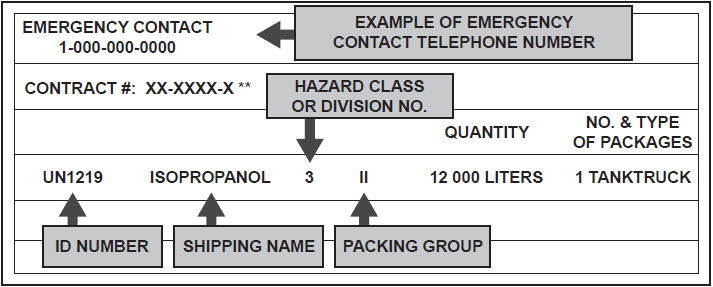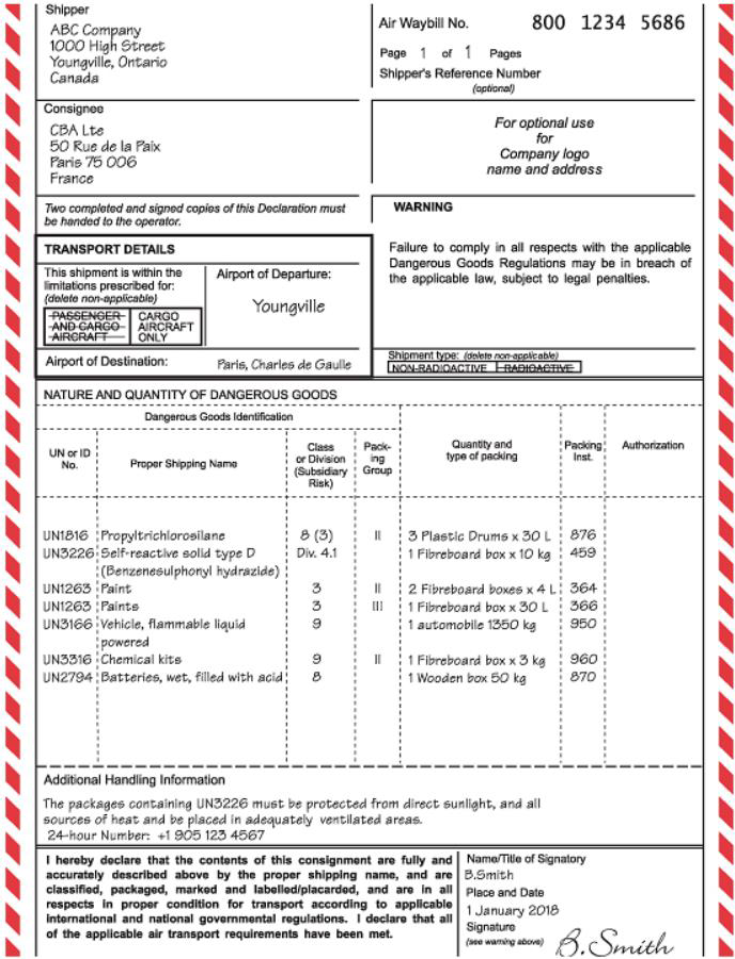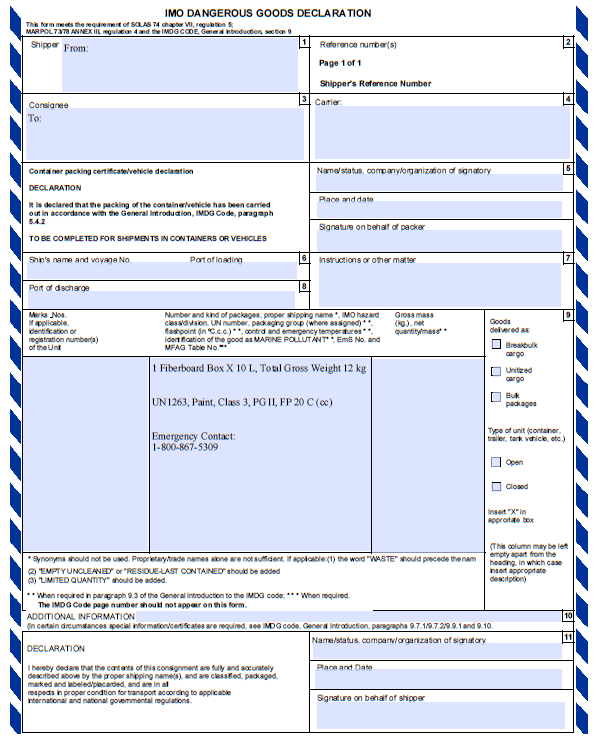The DG Shipping Process – Part 4 – Documentation (Step 6 of 7)
By Terry Poland, Principal Instructor and Consultant
Shipping dangerous goods for the first time? Or perhaps it has been awhile, and you just need a quick review of the process. Where to begin and what are the basic steps to follow? Airlines MUST use a checklist, but shippers and others are not required to – especially for surface modes such as ocean and ground transport. So what do we recommend? The answer is simple: a “process” that provides shippers with step-by-step guidance to assure all aspects of compliance are addressed in a logical order. While this process is not as detailed as the IATA Acceptance Checklist, generally it can be applied to all modes of transport – air, ocean or ground (highway and rail).
- Identification – Proper Shipping Name (with technical name for N.O.S. entries) & UN/Identification Number.
- Classification – Hazard Class and/or Division (subsidiary hazards, if any) & Assignment to Packing Group (PG I, II or III, if applicable).
- Packaging – UN Specification, Limited Quantity (LTD QTY), Excepted Quantity (EQ) and/or other exceptions granted by special provisions or packing instructions.
- Marking – Proper Shipping Name, UN/Identification Number, From & To Addresses, Quantity (if applicable), other shipment-specific markings as required.
- Labeling – Primary & Subsidiary Hazard Labels & Handling Labels (Orientation Arrows, CAO, others as applicable).
- Documentation – Shipping Paper (Dangerous Goods Declaration, Transport Document, Air Waybill, Bill of Lading, etc.).
- Other – Placarding/Special Provisions/State Variations/Operator Variations/Carrier Matters.
In Part 1 of this series, we covered Steps 1 & 2, Identification & Classification of the material. In Part 2, we covered Step 3, Packaging, where the shipper determines the quantity and type of packaging for the material. In Part 3, we covered Steps 4 & 5, Marking & Labeling. This brings us up-to-date with the current discussion in this article about Step 6, Documentation. It is important to note that throughout the different modal regulations (IATA, IMDG, 49 CFR), the term used to describe the dangerous goods documentation varies significantly. For example, in the IATA air regulations, the “Shipper’s Declaration for Dangerous Goods” (or “DGD” for short is used). In the IMDG ocean regulations, it is referred to as the “Transport Document.” And, according to the US DOT in 49 CFR (for ground and all modes), the official term is simply the “Shipping Paper.” In this article, I favor the US term, Shipping Paper, as it is generic and can be used as a multimodal description of the dangerous goods documentation.
Step 6 – Documentation:
As the old adage goes, “No job is done until the paperwork is complete,” certainly rings true for dangerous goods shipments. The Shipping Paper is the key form for hazardous materials communication between the shipper and carrier (and other intermediaries such as freight forwarders). Preparing the Shipping Paper is much easier than you think, as it is simply a recording of the data collected in the earlier steps along with a “certification/declaratory statement” that is signed to signify compliance. Nevertheless, accurate and complete shipping papers are one the most critical shipper responsibilities to properly describe the dangerous goods/hazardous materials to all parties in the transportation process. These documents must contain the correct information in the correct order to be complete and compliant. Most importantly, certain key elements are required for all modes of transport.
In spite of the importance of the dangerous goods shipping paper, there is no specific document format required by the US DOT in 49 CFR or any governmental regulation. Therefore, it is not the format of the shipping paper itself, but rather the information it contains which must meet regulatory standards. The only non-governmental organization that requires a standard format document shipping document is IATA which requires the “Shipper’s Declaration for Dangerous Goods” (or “DGD” – “Dangerous Goods Declaration”) based on the specifications contained in the IATA Dangerous Goods Regulations (DGR). The DGD may be printed in black and red on white paper, as shown in IATA 8.1.7, or it may be printed in red only on white paper. The diagonal hatchings printed vertically in the left and right margins must be printed in red.
Because the Shipping Paper provides all the details regarding the transport of each Hazardous Material shipment, naturally it must be retained as a go-to record in the event of an accident or incident. For this reason, parties involved including shippers and carriers must maintain these records as follows:
Shippers: Two (2) years from date of initial acceptance by the carrier
Carriers: One (1) year from date of initial acceptance by the carrier
The shipper is responsible to look up the article or substance in the alphabetically arranged List of Dangerous Goods/ Hazardous Materials Table (IATA DGR 4.2; 49 CFR 172.101; IMDG General Index) to verify the correct proper shipping name, hazard class/division (and, if applicable, any subsidiary hazards) and packing group (if applicable).
Many generic proper shipping names, those ending with “N.O.S.” (Not Otherwise Specified), require the addition of the “technical name” (primary chemical constituents) to be added in parenthesis following the proper shipping name. Each of the three primary regulations use a different symbol or code to indicate these requirements as follows”
- IATA (Air) – A star symbol located next to the proper shipping name in Column B of the DG List;
- IMDG (Ocean) – A reference to special provision 274 in Column 6 of the DG List;
- 49 CFR (Ground) – A reference to the letter “G” (Generic) in Column 1 of the Hazmat Table.
Preparing the Shipping Paper starts with the recording required Information (Basic Description) in a mandatory sequence as shown in RED. Under IATA (ICAO) & IMDG and 49 CFR, the following information must be on the shipping papers and in this order (note: the word “Class or Division” may be inserted; “PG” may be inserted):
1. I – Identification Number (UN/ID/NA Number)
2. S – Shipping Name (Proper Shipping Name) – plus (Technical Name), for most N.O.S. entries
3. H – Hazard Class/Division (followed by sub-hazards, in parenthesis, if applicable)
4. P – Packing Group (if applicable) – Classes 1, 2, 7 & articles do not have packing groups
Examples of the Basic Description (non-ocean shipments):
UN 1263, Paint, Class 3, PG II
UN 1072, Oxygen, compressed, 2.2 (5.1)
UN 1993, Flammable Liquid, N.O.S. (contains Acetone), 3, III
UN 3480, Lithium Ion Battery, Class 9
UN 3481, Lithium Ion Battery Contained in Equipment, 9
Examples of the Basic Description (ocean shipments require the addition of the flash point for Class 3, Flammable Liquids):
UN 1263, Paint, Class 3, PG II, FP 20 C (cc)
UN 1072, Oxygen, compressed, 2.2 (5.1)
UN 1993, Flammable Liquid, N.O.S. (contains Acetone), 3, III, FP 45 C (cc)
UN 3480, Lithium Ion Battery, Class 9
UN 3481, Lithium Ion Battery Contained in Equipment, 9
Other Required Information in RED – All Modes (or as applicable to shipment)
Entries can be separated by spaces, commas or slashes (commas are more common). Entries in RED apply to most shipments; non-red entries are shipment-specific (apply to only some shipments):
- Total Number of Packages, Type and Quantity
- Emergency Response Phone Number
- Emergency Response Written Information
- Air shipments require the IATA Packing Instruction specific to each material shown on DGD
- Air shipments require the designation of Cargo Aircraft Only, if applicable, on DGD
- Air shipments require the designation of Radioactive Materials, if applicable, on DGD
- Ocean shipments for Class 3 required the flash point in a closed-cup (“cc”) measurement
- Statement: “DOT E Number …”
- Statement: “Limited Quantity” or “LTD QTY” (Air shipments do not require this notation)
- Hazardous Substance: Reportable Quantity “RQ” per 49 CFR 172.101, Table 1 to Appendix A
- Statement: “Dangerous When Wet”
- Statement: “Poison/Toxic Name”
- Statement: “Poison/Toxic Inhalation Hazards – PIH Hazard Zone”
- Statement: “Store out of direct sunlight and away from all sources of heat”
- Attachments: Applicable Special Permits Verified & Noted “Attached”
- Shipper’s Certification Statement (See example below)
- Shipper’s Certification Signature (IATA does not allow type-written signatures)
The Shipping Paper must be legibly signed by a principal, officer, partner, or employee of the shipper or his agent, and may be signed manually, by typewriter, or by other mechanical means.
Example Shipper’s Certification Statement:
I hereby declare that the contents of this consignment are fully and accurately described above by the proper shipping name, and are classified, packaged, marked and labelled/placarded, and are in all respects in proper condition for transport according to applicable International and National Governmental Regulations. I declare that all of the applicable transport requirements have been met.
In addition, Per 49 CFR, Subpart G (172.600 – 172.603), the United States requires that the shipper provide emergency response information including a 24-hour emergency contact telephone number on the shipping paper (located near the Basic Description) and written emergency information available away from the package. This information is not required for shipments that do not require a Shipping Paper.
Exceptions from Emergency Response Telephone Number:
Hazardous materials offered for shipment under the Limited quantity provisions or as any of the following shipping names: Battery powered equipment; Battery powered vehicle; Carbon dioxide, solid (dry ice); Castor bean/flake/meal/pomace; Consumer commodities; Dry ice (Carbon dioxide, solid); Engines, internal combustion; Fish meal, stabilized; Fish scrap, stabilized; Krill Meal, PG III; Refrigerating machines; Vehicle, flammable gas powered; Vehicle, flammable liquid powered; Wheelchair, electric.
Shipping Paper (DGD) Examples (Ground, Air, Ocean) shown below:
49 CFR, Ground (highway & rail), Shipping Paper:

IATA, Air, Shipper’s Declaration for Dangerous Goods (DGD):

IMDG, Ocean, Transport Document: NOTE: The IMDG Regulations require a separate “Container packing certificate/vehicle declaration” to be completed when applicable to the shipment.

We hope you enjoyed this article and find this information useful. Please feel free to bookmark it in your browser and recommend it to others who may benefit.
Finally, just as a reminder, this article is entitled, “The DG Shipping Process – Part 4 – Documentation (Step 6 of 7).”
Please watch for the final article in this series, “The DG Shipping Process – Part 5 – Other Requirements (Step 7 of 7)” – coming soon!
For support requests, please feel free to contact us at support@dgtraining.com.
